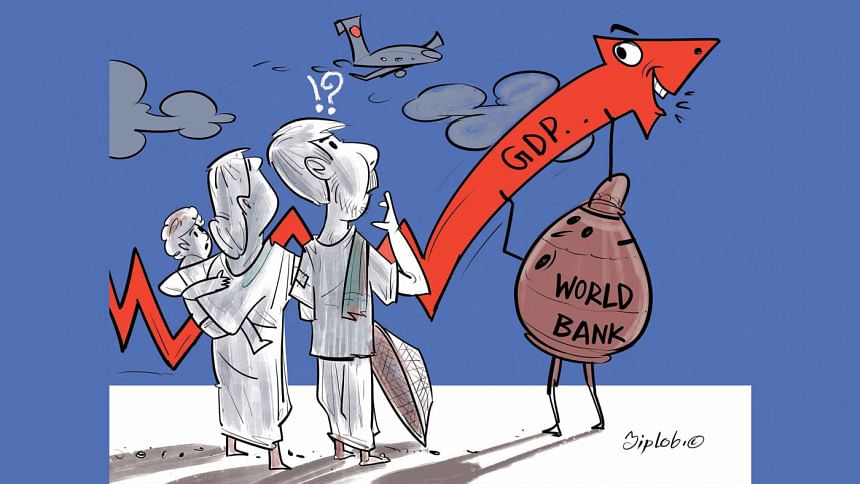GDP: A misleading measure of development

Annual GDP refers to the financial value of all the products and services produced in a country in a given year. This means as a country's financial transactions increase, so does GDP. GDP growth in Bangladesh has been relatively good over the past decade. According to government estimates, Bangladesh's per capita income has now exceeded USD 2,800 a year. However, many reasonable questions are being raised about the methods used to measure GDP—as well as the acceptability and reliability of the data used to do so. Our obsession with GDP has overshadowed many urgent questions.
While there can be many questions about how much has been achieved and how, there is no doubt that our national income has increased. When it comes to measuring a country's economy with GDP, we follow the guidelines of the World Bank and IMF. The World Bank divides the world's countries into four main categories on the basis of per capita income: 1) Low-income countries (per capita income up to USD 1,025); 2) Lower-middle-income countries (USD 1,026-4,035); 3) Upper-middle-income countries (USD 4,036-12,475); and 4) High-income countries (more than USD 12,476).
Bangladesh became a lower-middle-income country in 2015. According to the rules of international organisations, Bangladesh is no longer eligible for certain facilities, such as special benefits of the World Trade Organization (WTO) meant for low-income countries, and loans at low interest rates.
Reviewing the experiences of different countries, Nobel laureate Amartya Sen has shown that even if a country's GDP is very high, its performance when it comes to sustainable development can be weak. Even if a country's per capita income is high, the standard of living of the majority of its people can be low. In many African countries, the per capita income is higher than that of Bangladesh. Although they graduated to the middle-income status way before Bangladesh, the living standards of their populations are still poor. When Nigeria's per capita income was more than double our income, it could not be said that their standard of living was twice as good as ours. Sri Lanka's per capita income was higher than Bangladesh's, but that could not prevent their economic crisis.
Therefore, we can only get an idea about a country's financial transactions, commercial production, distribution, and the availability of services from per capita income, but it cannot perfectly depict the socioeconomic situation of the country. Rather, in a society where inequality is high, the average income estimate gives some misleading information. If one family earns Tk 10 lakh and another family earns Tk 10,000 per year, then the annual average income of both the families stands at Tk 5.05 lakh. Does their average income explain the financial reality of the two families?
In fact, the per capita income of 80 percent of Bangladesh's population is less than 30 percent of the official figure. The top five percent of the population have one-third of the GDP. Black money or the thousands of crores of taka that is laundered abroad is not taken into account in this estimate. Since a large amount of wealth is concentrated in the hands of a small group, even though the GDP swells, the condition of ordinary people remains unchanged, if not worsened.
In fact, remittance and RMG are the major contributors to the steady growth of GDP and per capita income in Bangladesh. There is also the agriculture sector, as well as non-institutional sectors. But both income and safety of life of those working in these sectors are uncertain. While the GDP increases due to the corrupt activities of people involved in money laundering, the livelihood of a large section of society remains precarious. GDP can also increase through the grabbing and destruction of rivers, canals and forests, but that does not ensure sustainable development—rather, it puts the economy and the livelihood of a large number of people at risk. When the project costs increase due to corruption and wastage, the annual development programmes also look big, and the GDP figure also increases. In addition, people's access to education and healthcare has decreased due to increased cost and commercialisation of these basic services. But this increased cost also increases the GDP.
The Sundarbans saves the lives and properties of millions of people during natural disasters, but that does not counted in the measurement of GDP. On the other hand, if a coal-fuelled power plant is constructed there by destroying the Sundarbans, there will be irreparable damage to the country and its people—they will be vulnerable to natural disasters—but it will increase the GDP.
Doubts are now rising in mainstream economies about measuring development on the basis of GDP and per capita income. That is why many ways and methods, such as Human Development Index, Genuine Progress Indicator, Gross National Happiness, etc are used to measure development in many countries. Despite being a so-called underdeveloped country, Bhutan is far ahead of Bangladesh with regard to per capita income. When the per capita income in Bangladesh crossed USD 1,200, Bhutan's per capita income was more than double that figure—USD 2,500. Instead of obsessing over the per capita GDP, Bhutan rejected the method of GDP calculation and invented their own method to measure development, focusing on nine areas: psychological well-being, use of time, community vitality, cultural diversity and resilience, ecological resilience, standard of living, health, education, and good governance.
It is possible to hide many qualitative aspects of GDP by only highlighting the quantitative aspects. This is convenient for the government, the corporate groups and their economics. Due to the nature of various development projects, loans and taxes are also increasing in the country. Along with the increased cost of living, destruction of our rivers and forests are also continuing. If our GDP increases in this way, the country will be in danger in the long run.
Therefore, in order to measure real development, we need to take into account the qualitative aspects, rather than focusing on quantity only. Socio-environmental damages and opportunity costs must be included in the measurement as well.
The article was translated from Bangla by Naznin Tithi.
Anu Muhammad is a professor of economics at Jahangirnagar University.

 For all latest news, follow The Daily Star's Google News channel.
For all latest news, follow The Daily Star's Google News channel. 




Comments